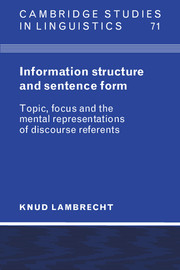 Information Structure and Sentence Form
Information Structure and Sentence Form Published online by Cambridge University Press: 05 June 2012
This book proposes a theory of the relationship between the structure of sentences and the linguistic and extra-linguistic contexts in which sentences are used as units of propositional information. It is concerned with the system of options which grammars offer speakers for expressing given propositional contents in different grammatical forms under varying discourse circumstances. The research presented here is based on the observation that the structure of a sentence reflects in systematic and theoretically interesting ways a speaker's assumptions about the hearer's state of knowledge and consciousness at the time of an utterance. This relationship between speaker assumptions and the formal structure of the sentence is taken to be governed by rules and conventions of sentence grammar, in a grammatical component which I call information structure, using a term introduced by Halliday (1967). In the information-structure component of language, propositions as conceptual representations of states of affairs undergo pragmatic structuring according to the utterance contexts in which these states of affairs are to be communicated. Such pragmatically structured propositions are then expressed as formal objects with morphosyntactic and prosodic structure.
My account of the information-structure component involves an analysis of four independent but interrelated sets of categories. The first is that of propositional information with its two components pragmatic presupposition and pragmatic assertion. These have to do with the speaker's assumptions about the hearer's state of knowledge and awareness at the time of an utterance (Chapter 2).
To save this book to your Kindle, first ensure [email protected] is added to your Approved Personal Document E-mail List under your Personal Document Settings on the Manage Your Content and Devices page of your Amazon account. Then enter the ‘name’ part of your Kindle email address below. Find out more about saving to your Kindle.
Note you can select to save to either the @free.kindle.com or @kindle.com variations. ‘@free.kindle.com’ emails are free but can only be saved to your device when it is connected to wi-fi. ‘@kindle.com’ emails can be delivered even when you are not connected to wi-fi, but note that service fees apply.
Find out more about the Kindle Personal Document Service.
To save content items to your account, please confirm that you agree to abide by our usage policies. If this is the first time you use this feature, you will be asked to authorise Cambridge Core to connect with your account. Find out more about saving content to Dropbox.
To save content items to your account, please confirm that you agree to abide by our usage policies. If this is the first time you use this feature, you will be asked to authorise Cambridge Core to connect with your account. Find out more about saving content to Google Drive.